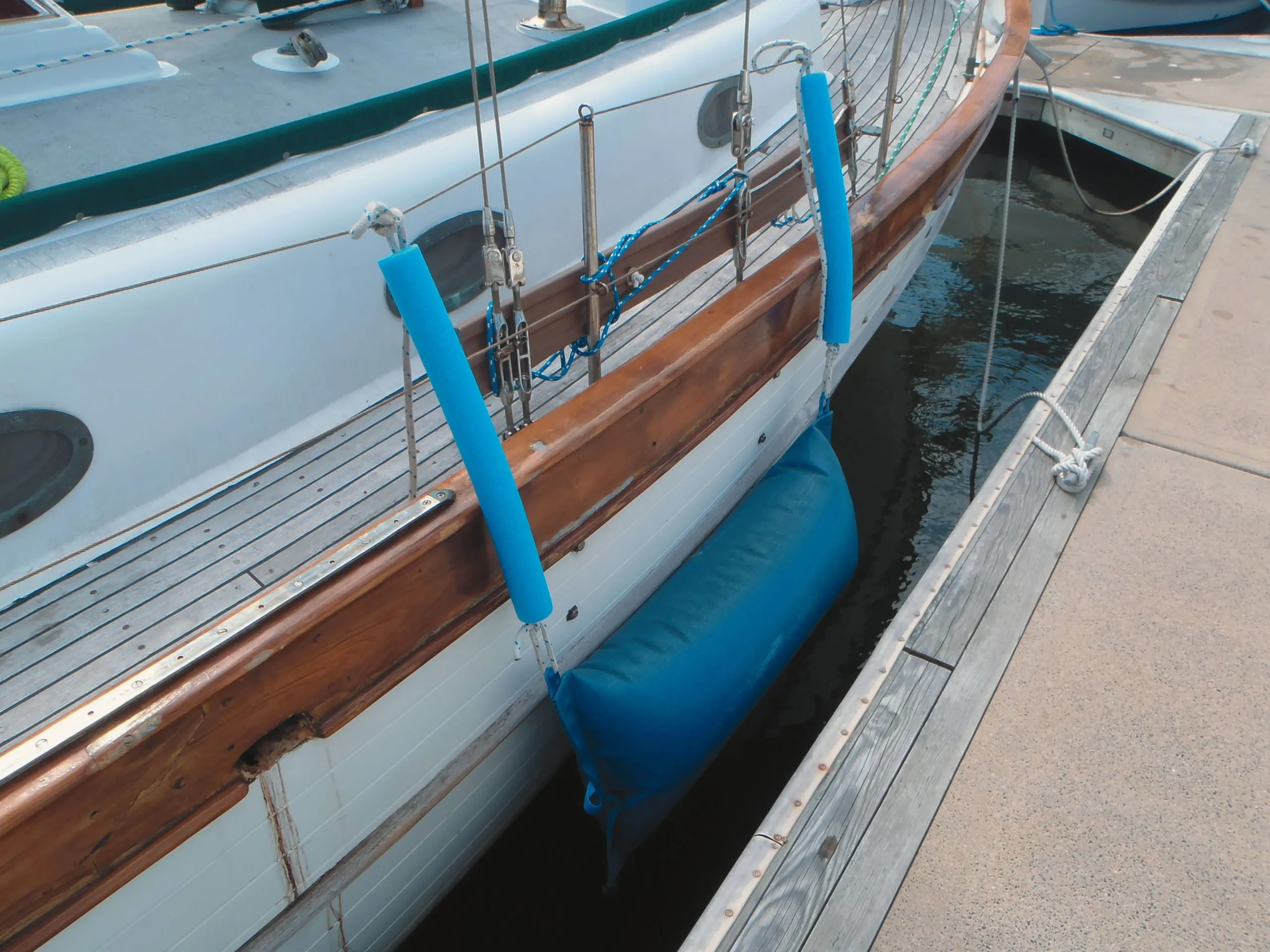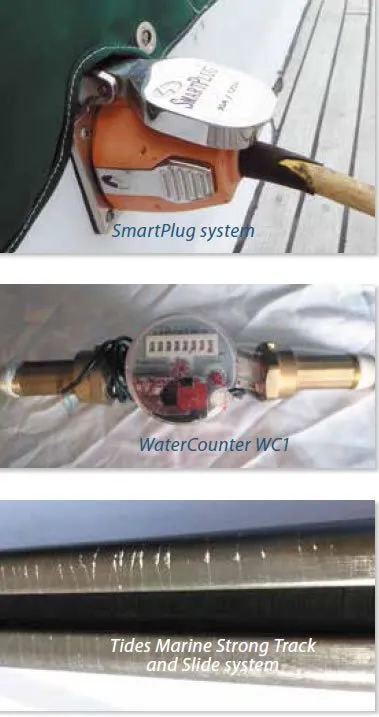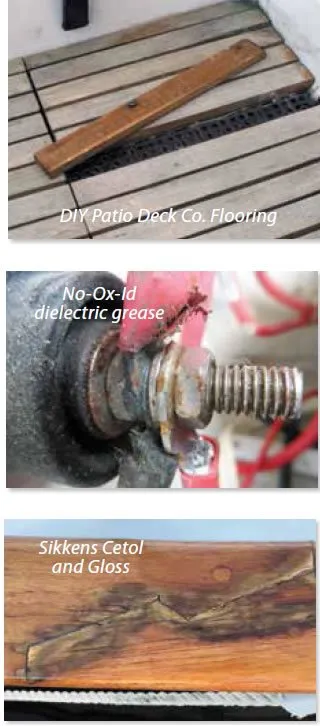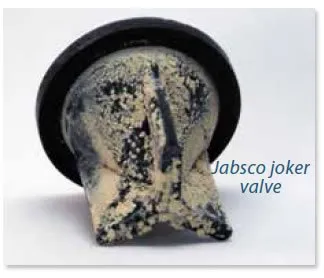Many of Practical Sailors tests move from the lab (workshop/garage/driveway) to our fleet of test boats, where we can evaluate the top products in real-world conditions over the long haul. These long-term tests can last from two to 10 years, and we try to offer occasional updates on their status, when its warranted.
Heres a look at how some of those long-term tests are going aboard two Chesapeake Bay-based test boats, one a PDQ 32 catamaran and the other a Union 36 cutter. Both test boats are sailed regularly and are used for multi-week (or months) cruises annually.
Seoladair Easystow fender
The Seoladair Easystow was named the Best Choice inflatable fender in the July 2008 issue and was reported to be showing signs of reasonable wear-and-tear in the December 2010 long-term test update. The test fender (10 x 36 inches, model FH1036, currently $116) has been in use as the primary fender-constant use through both heat and cold-for our Union 36 test boat, both in the slip and when rafted up with other boats, since July 2008.
The fender is relatively light and easy to work with. It takes the place of two cylindrical or ball-type fenders and can also serve as a fender board replacement in a pinch. Unlike poly-plastic fenders, the blue material doesn’t develop the gummy grime that can mar gelcoat. As with any inflatable fender, the air inside expands in hot weather and makes it extra firm, and in cold weather, it deflates a bit. We found a happy medium and seldom had to make adjustments except during major extremes in heat and cold.
In December 2013, our test fender developed an internal leak so we sent it back to the manufacturer for evaluation. (The fender comes with a lifetime warranty against defects, which makes this an option for any buyer.) The problem turned out to be a small leak at one of the welds for the inner liner. The manufacturer explained that since our test model had been produced, they have moved from a 3-mil urethane liner to a 10-mil urethane liner, one thats tougher and has more consistent welds. Seoladair replaced the liner in our fender and returned it to us as part of the warranty coverage.
Bottom line: After many years of constant use, our test fender exhibited very reasonable wear and tear. In January 2014, we outfitted the test boat with two more larger, heavy-duty 12- by 44-inch fenders. Theyre performing as well as our original test fender, and we expect they will continue to do so for years to come. The added bonuses are great customer service and an excellent warranty.

The Wirie
We installed The Wirie AP (see PS April 2010 online) on our test boat in July 2012. Weve used it during weekend trips and longer cruises, most recently during a months-long cruise along the U.S. East Coast to the Bahamas and back.
In 2013, the unit failed, and we returned it to the manufacturer for evaluation. The maker explained that the problem stemmed from a circuit being sensitive to spikes and surges in DC power; this circuit would blow sometimes, causing damage to the unit. Although the unit was out of warranty, the maker fixed it for us at no charge.
During the last cruise, testers noted the dwindling number of free or unprotected Wi-Fi hotspots. For the most part, our primary use of The Wirie was to pull in complementary, password-protected wireless service from the marinas we stayed in that offered it. Operation of The Wirie itself was hit or miss. Getting it to work would often involve numerous resets, re-boots, and other such shenanigans.
Since our test started, the maker has replaced The Wirie AP with The Wirie AP+, which has new hardware and is designed to be much more durable and easier to use. We plan to test another new Wirie product, the Pro model, in the near future; it provides both Wi-Fi and 3G/4G data connections.
Bottom line: When the AP worked, it worked great. When it didnt, it was no surprise. The model we tested has been discontinued, but we plan to test its successor, the Pro, soon. For other options, check out our last review of Wi-Fi boosters (PS April 2014) and look for our ongoing test report on current market offerings in a future issue.

SmartPlug
We installed the SmartPlug power inlet and shore-power plug on our test boat in 2010 (see PS June 2010 online), and it has been in daily use since then. The installation was easy (the inlet utilizes the same hole and screw pattern as our old twist-lock shorepower setup), and adding the plug to our AC shore-power cord was straightforward.
Robust and well-constructed, the SmartPlug has held up well and has worked great overall. We also like the thermal protection it provides; however, the internal thermal switch will cut out if the plug temperature reaches 200 degrees (per the manufacturer). The downside is that the switch resets itself once it cools back down, even though what initially caused the overheating may not have been repaired. Our preference would be for the switch to remain off until the circuit has been inspected and repaired as required. That being said, the protection it offers is way better than nothing, which is what you get with a traditional twist-lock plug. Worst-case scenario, the cut-out temperature is low enough that it should simply continue to cycle on and off (without causing a fire) until the problem is addressed.
Testers noticed that the plug on our SmartPlugs power cord was loose in February 2014 (while in the Bahamas). After opening it up, we discovered that one of the fingers for the internal cord-strain-relief clamp had broken off, allowing the cable to move in and out of the plug. The weatherproof sleeve for the cord was also deteriorated and had split where it joined the plug. After a bit of thought, we came to the conclusion that the strain relief clamp damage likely occurred as a result of someone stepping on or tripping over the cord while it was plugged it. The sleeve failure looked to be the result of UV damage, but being stepped on could have led to an early demise.
The SmartPlug comes with a seven-year limited warranty, so after we discussed the issue with the manufacturer, they sent us a new plug. As there was nothing really wrong with the rest of the plug, they could have just as easily sent replacement components, but replacing the plug was a nice touch.
Bottom line: Testers really prefer the $165 SmartPlug to the old style twist-lock connector. It is robust, waterproof, and easy to plug in (even in the dark). It also locks into place easily, without the use of those aggravating threaded securing rings.

WaterCounter
In 2010, we installed the WaterCounter WC1 water management system to help keep track of our test boats freshwater use. The system ($395) comprises two main parts: a computerized digital display and a sender unit that counts the gallons as they are used. The sender is installed inline on the pressure side of the freshwater pump, while the display can be wired and mounted anywhere up to 100 feet away (galley, nav station, etc).
The system was easy to install and operating instructions were simple. The display comes preset from the factory to read from zero upward. For the initial setup, you just fill your water tank, then use water until the tank is empty. The amount shown on the display tells you in gallons how much water you can access from your tank (for our test vessel, it was 76 gallons). We then reprogrammed the display so that it counted down from 76 gallons. After that, all we had to do was press the reset button each time we filled the water tank. Tank capacity is then displayed in gallons, and the WaterCounter Water Management System deducts the gallons of water as they are used and displays the remaining amount.
The system worked flawlessly for more than five years, through weekend jaunts and monthslong trips along the Intracoastal Waterway and to the Bahamas. Customer service was great as well-we needed it twice. We had some problems during the initial installation, and when called, the maker walked us through the setup and provided troubleshooting tips to find the problem (which turned out to be a bad butt-joint connection).
However, in October 2015, the system stopped working. The display would reset, show 76 gallons and the little flow indicator wheel on the sending unit spun as water flowed through the sensor, but there was no final countdown. After using the provided troubleshooting tips, testers determined the problem was with the sensor; we called the company to confirm. The solution? Replace the out-of-warranty sensor: $195 plus $15 shipping.Ouch.
Bottom line: Testers liked the system overall. It is a simple, accurate way to tell at a glance how much water you have remaining at any given time, regardless of the tanks shape or whether the vessel is heeled. It seems a shame there are no repair options for the sensor unit (which has only a one-year warranty), as it is a robust, well-built piece of gear. Before shelling out $200-plus for a replacement, we plan to open it up to see if we can somehow bring it back to life.

Tides Marine Strong Track
During the replacement of our test boats mainsail (see PS August 2011 online), we took a look at possible mainsail-handling upgrades. After discussing various options with our sailmaker, we decided that the biggest bang for the buck upgrade would be installing a Tides Marine Strong Track and Slide System. The system is a mainsail luff track and slide assembly that greatly reduces the friction normally associated with raising and lowering the mainsail. The track is a single length of ultra-low friction, ultra-high molecular weight plastic that is machined to slide onto your existing mast track. Installation was simple and straightforward, and it made a major, noticeable difference in the ease of raising and dousing our new sail.
The system has worked flawlessly for over four years, allowing us to easily raise and douse the main at numerous points of sail. The unit does have some minor surface cracking on its outside face-the result of exposure to ultraviolet rays-but it appears to be cosmetic only at this point.The system has a two-year warranty, but in cases of UV degradation within four years, owners can replace the track at a 40-percent discount.
Bottom line: The Tides Marine Strong Track and Slide System has proven to be an excellent upgrade to improve mainsail handling. It was worth every penny of the $28 per foot it cost; price included the slides and batten receptacles.

DIY Patio Deck Co. Flooring
In the summer of 2011, we installed inexpensive, pre-assembled, snap-together wood-grate tiles from the DIY Patio Deck Co. (see PS October 2014 online) in our cockpit well. Surprisingly, five years later, the wood is holding up just fine; we chose acacia wood, but other types are available. It does need a light sanding and refinishing every two years to keep it looking its best, but there are no signs of softening, cracking, or rot.
Unfortunately, the plastic backing has not held up as well as the wood. The plastic was low quality, and right at the companionway, a few boards have come loose. (Interestingly, we didnt notice this until we got on our knees and started poking boards for this update as they had stayed in their slots anyway.)
The wood surface and the underfoot feel have been a big hit with the family, so we will not be replacing the acacia decking, just replacing the underlayer. The final solution may require a bit more work, but it should still be cost and labor effective.
Bottom line: These tiles have proven to be as durable as they are easy to install, cost effective ($7 per 12-inch square tile), and easy on the feet. The company would do well to improve the backing material.

Sikkens Cetol and Marine Gloss
In March 2008, we applied three coats of Interluxs Sikkens Cetol Marine Natural Teak and Marine Gloss (clear) to the Union 36s newly sanded, bare teak caprail and bulwarks. For the following two years, we applied a maintenance coat of Marine Gloss every six months, as Interlux recommends. After that, our brightwork maintenance routine became more inconsistent: Six months between coats stretched into a year, then two or even four. Why did we become such slackers? Was it a general malaise regarding maintenance or was it because the coating still looked decent enough to justify (in our mind) skipping the recommended maintenance coat? Whatever it was, here it is 2016, and applying a maintenance coat is still on the to-do list.
The coating is definitely looking long in the tooth and in need of stripping and fresh coating, but it actually still looks pretty decent overall (even better from 15 feet away).
While Cetol is easier and more forgiving to apply than a standard varnish, the finish is also a lot softer. This is particularly noticeable where rubbing can occur (like where our fender lines rest against the edge of the caprail). We spot treated these areas, but we could never seem to get the color to match up very well. Water had a tendency to creep under and lift the coating around the damaged areas when we waited too long to do spot repairs. In some cases, we pulled the coating off in rubbery patches, although this would probably have been less dramatic if spot repairs had been done as soon as we noticed the damage.
Bottom line: In both panel tests and real-world tests, weve been pleased with the performance of the Cetol Natural ($33/quart) + Marine Gloss ($35/quart). The finish was easy to apply and has held up well over the years, despite our decline in maintenance morals.
Banner Bay Marine FinDelta
First reviewed in our December 2007 issue, the Banner Bay Marine FinDelta is a radically designed anchor-riding sail that uses three panels instead of the traditional single panel construction. Testers used the FinDelta multiple times over the last eight years. It has performed well overall, and once we figured the best locations for the attachment points (for optimal performance and to prevent chafe), we were able to get it up and going in less than 3 minutes. The sail itself is also holding up well and still looks great after more than eight years.
Bottom line: We don’t need or use the FinDelta at every anchorage, but its a great piece of gear to have when you need it. At $395, the FinDelta isn’t cheap, but its quality construction and proven durability make it a worthy investment, in our view.
Biobor EB gasoline additives
After years of enduring ethanol fuel-induced nightmares, we decided it was time to get to the root of the problem and took a look at gasoline additives, fuel-system practices, and fuel-vent filters.
Our initial gas additives corrosion testing (see PS November 2012 online) convinced us to switch to the PS Best Choice Biobor EB. Last fall, after four years of using the Biobor, we opened the carburetors in two test outboards and found zero corrosion. The tests that followed that initial report supported our additive choice.
The big takeaway from all of our fuel additive testing was that better fuel management practices meant healthier fuel and less troublesome outboards. Best practices include filling the dinghy tank after use rather than before and always closing the tank vent when its not in use. We went from routinely having starting problems with our Mercury 3.5-horsepower dinghy engine after a rainy night, to just two to three pulls even after a three-month layup. Adding a lawn mower-type filter inline helped too; the outboard had no filter, only a tank outlet strainer.
Bottom line: Biobor EB ($21/16 ounces) remains our Best Choice.
H2Out Gas Vent filter
We have been testing silica gel-filled vent filters made by Pindell Engineering (H2Out ADV2, $130) and of our own do-it-yourself design for three years. We learned that the silica gel is self-regenerating in ethanol (e-10) applications (the ethanol scrubs the water out during out-breathing), reduces volatiles loss (less odor at the vent, more volatiles stay in the tank to ease starting), and can eliminate the water separation we occasionally experienced.
Since our test began, the H2Outs polycarbonate filter shell was changed to an aluminum one. The company made the change after a customer accidentally cracked a filters shell while refilling it. When refilling any adsorbent filter, fuel or holding tank, be careful to keep the sealing surfaces clean.
Our testers with diesel vent filters are reporting similarly good results, including some in very damp climates (Maine and Pacific Northwest), with less moisture observed in the fuel and no condensation. The projected life expectancy of the adsorbent fill in diesel applications is less than for e-10 (no ethanol scrubbing affect), but we think three to five years is a reasonable expectation.
Bottom line: We expect the silica-gel fill to last for seven to 12 years, saving enough fuel in the process to pay for the filter installation; the improved fuel quality, improved starting, and increased carbon life are just free side benefits. Both our DIY vent filter and the H2Out unit are holding up well after three years.
No-Ox-Id dielectric grease
After spending too much time chasing down intermittent electrical problems caused by corrosion on a new-to-us boat, we began researching anti-corrosion treatments. For over a year, we tortured crimps and spade connectors in a salt-spray chamber, destroying aluminum terminal blocks, corroding tinned and non-tinned wire, and creating failures in push-on connectors.
In the end, heavy dielectric grease and a few sprays provided real protection. Noalox (aluminum wiring corrosion preventative) and No-Ox-Id (terminal grease) out-performed all others by a wide range.Weve continued to use the No-Ox-Id ($12/8 ounces) on board and have had no electrical connection corrosion or other wiring problems. Weve also been using the thin-film Corrosion Block spray on our shorepower plug; its proven to be a winner in that application, eliminating corrosion and subsequent heating.
Bottom line: Since we started using No-Ox-Id and waterproof dielectric grease on electrical connections, even the most previously challenging sump pump and outboard connection have been 100-percent trouble free.
Line Coatings
A surprise find in our long-term testing was the effectiveness of Spinlocks RP25 ($60/250 milliliters) and New England Ropes Maxijacket anti-abrasion line coatings ($45/quart). Weve been using the stuff on mooring lines, furling lines, and anchor bridles for several years and have been very satisfied with the results.
Bottom line: Although they do stiffen the lines somewhat and are not recommended for portions of lines that are handled or winched, in the right applications they greatly extend rope life. We estimate they decrease the wear to lines three to five times that of untreated lines.
Raritan PHII Joker valve
While initial lab testing suggested that the Jabsco joker valve might be the Best Choice (less leakage, more flexible) for the ubiquitous Jabsco manual heads (see PS July 2013 online), extended testing by multiple users, including live-aboards, returned a unanimous opinion that the Raritan PHII joker valve fits in the Jabsco manual head just fine and lasts two to three times as long as the Jabsco valve. Instead of annual changes, were getting two to three years out of a Raritan valve in intermittent use, and on live-aboard boats, its lasting more than one year without leakage.
We also learned that completely rebuilding Jabsco heads is a fools errand; the parts cost nearly as much as a new pump assembly. Replace the pump and you have, in effect, a new head.
Bottom line: For Jabsco manual heads, the Raritan PHII joker valve ($15) works as well and lasts longer than its Jabsco counterpart ($15).
Sanitation Hose
Following our April 2012 and December 2013 reports, we installed a variety of waste hoses on test boats (Trident 102, Raritan Saniflex, Sealand Odor Safe Plus, and Shields Poly-X). None has failed since the Trident clear vinyl hose failed a few months into testing (as reported in 2012).
Bottom line: The Shields Poly-X ($178, 1-inch by 12.5 feet) remains the easiest to keep clean, and the Trident 102 is the most mildew-prone.
Holding Tank Vent Filter
We reviewed carbon-filled holding tank odor-control filters in the March 2013 issue, followed by a 30-month update in the December 2013 issue. Testing included a number of commercially available holding tank vent filters and a home-built filter. Most of the commercial filters and the home-built filter performed very well on the test stands, reducing a very objectionable odor to one that wasnt noticeable, not even near the vent or while flushing.
We left the home-built filter (about the same carbon capacity as commercial units) installed on our test boat to see how the real world of rough seas and pumpouts affected long-term performance. After three years and four months of exceptional service-including regular weekend sailing and four weeks of cruising each season-the carbon in the home-built filter gave up, allowing traces of odor through. Other test boat filters, installed for shorter periods, have not failed.
Vent filter maker Big Orange has improved its OEM model, which is a drop-in replacement for commercial filters. The new filter is easily refilled by removing the end cap, and includes a vacuum break, similar to the standard Big Orange filter, to eliminate the risk of tank collapse during pump-out if the filter were plugged. Testers have not yet needed to refill the Big Orange filter ($103), even after 14 months of use.
Bottom line: Based on our experience and feedback from others, the typical weekend warrior can expect three years of service and a full-time cruiser or live-aboard can expect about one year from a carbon vent filter.
Mildew treatment
In the November 2013 issue, we reported that two home-brew recipes, Formula A and Formula B, had out-performed all commercial mildew treatments and stain removers that we had tested in a side-by-side incubator. In the three years since we used the homemade formulas to treat our test boat, no mold has returned in those areas. We also used this recipe in multi-gallon quantities at home after a few basement flooding episodes, and it performed far beyond our expectations.
Bottom line: Our homebrews are still our go-to formulas for marine and home mildew issues, but we also recommend considering quaternary amines (PS September 2015) for use on synthetics and for on-deck cleanup and protection.
Eva Dry 2200
The Eva Dry 2200 dehumidifier ($80) we reported on in the June 2013 issue is still ticking and removing the same amount of water after three years of nearly continuous use, despite being knocked around hard a few times when we forgot to remove it from the countertop before getting underway. Weve found it to be quiet and dependable, and our boat has never been so odor-free.
Bottom line: If you don’t need the capacity of a compressor dehumidifier, the Eva Dry is a proven choice.
Conclusion
We didnt have many failures or disappointments in this batch of long-term tests, but that shouldnt be much of a surprise: Only the top-rated test products make it into the long-term testing



































